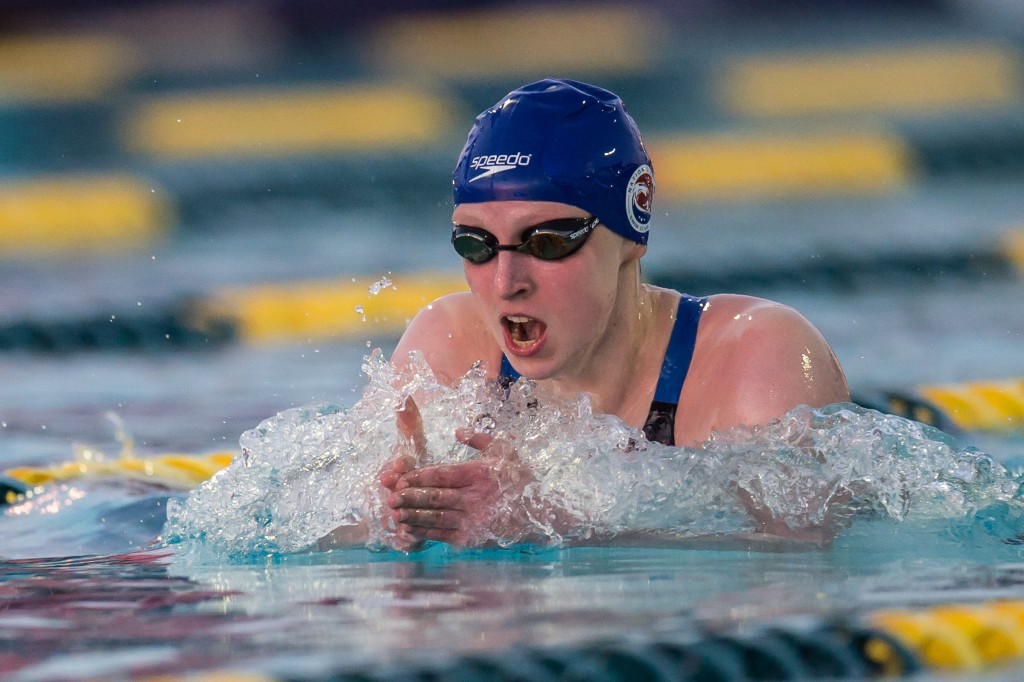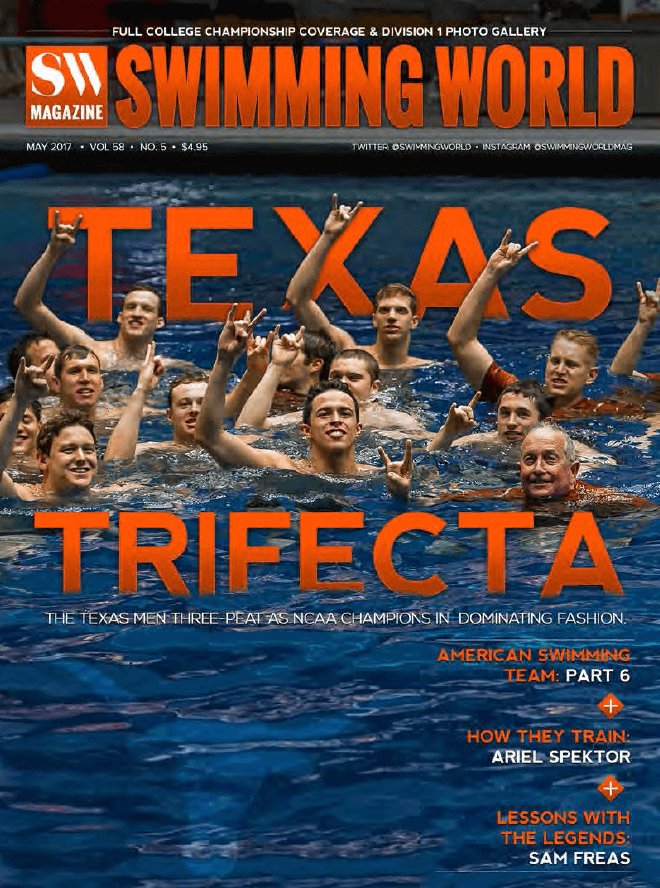Swimming World Presents “Technique Misconceptions: Breaststroke Hand Recovery”

Swimming Technique Misconceptions: Breaststroke Hand Recovery
Visit the Swimming World Magazine Vault to Read More.
Many people believe that it is worth copying the technique of the fastest swimmers. In reality, even the fastest swimmers have technique limitations, but they offset them with strength and conditioning. The purpose of this series of articles is to address scientifically the technique misconceptions that have become “conventional wisdom,” and to present options that are more effective.
This month’s article addresses the misconception that in breaststroke it is better to recover the hands above the surface than below the surface. The rationale is that recovering the hands above the surface causes less resistance. In reality, an above-surface recovery is less effective because it increases the distance that the hands travel, which slows the stroke rate. In addition, the upward hand motion encourages upward body motion, which angles the body and causes more resistance.
Dr. Rod Havriluk is a sports scientist and consultant who specializes in swimming technique instruction and analysis. His unique strategies provide rapid improvement while avoiding injury. Learn more at the STR website, or contact Rod through info@swimmingtechnology.com.
To read more about the misconceptions on breaststroke hand recovery, check out the May issue of Swimming World Magazine, available now!
[PHOTO BY PETER H. BICK]
Not a subscriber? Subscribe With This Special 3-Year Offer! Swimming World Magazine gives you unlimited access to all online content on SwimmingWorldMagazine.com and access to all of the back issues of Swimming World Magazine dating back to 1960! Visit the Swimming World Magazine Vault.
Order a single “Collectors” issue print copy here or download a single .pdf copy here.
Take a video tour of the current issue of Swimming World Magazine…
FEATURES
010 NCAA DIVISION I PHOTO GALLERY
by Peter H. Bick
018 STANFORD’S JUST BEGINNING
by Dan D’Addona, David Rieder and Annie Grevers
It took Stanford 19 years to return as NCAA Division I swimming and diving champions, but it looks like the Cardinal is ready to stay at the top for a few more years to come.
026 TOTALLY TEXAS
by Dan D’Addona, David Rieder and Annie Grevers
Coach Eddie Reese’s Longhorns simply did what they’ve been doing so well for the last three years: dominate the men’s NCAA Division I Swimming and Diving Championships.
035 BRING OUT THE BROOMS!
by James Sica, Diana Pimer, Chandler Brandes and Taylor Brien
That’s what the swimming and diving teams from Queens, Emory, Olivet Nazarene and Indian River did last March as they swept the women’s and men’s team titles at their respective NCAA-II, NCAA-III, NAIA and NJCAA Championships.
046 AMERICAN SWIMMING TEAM (Part VI): FUTURE—THE TOP OF THE TEAM
by Chuck Warner
If the American Swimming Team is going to maintain its superior position in the future, it must continue to look for ways to improve.
COACHING
038 LESSONS WITH THE LEGENDS: SAM FREAS
by Michael J. Stott
041 STARTS AND BREAKOUTS
by Michael J. Stott
This is the first of a multi-part series on “trained behaviors” in swimming. When applied to starts and breakouts, some of the nation’s best practitioners have developed methods of their own to produce successful outcomes that span seasons of competition and even careers.
044 SWIMMING TECHNIQUE MISCONCEPTIONS: BREASTSTROKE HAND RECOVERY
by Rod Havriluk
The above-surface hand recovery in breaststroke is very common and used by many elite swimmers. It is a misconception, however, that the above-surface recovery is more effective or faster than a below surface recovery.
048 SPECIAL SETS: TENNESSEE MID-SEASON SETS
by Matt Kredich with Michael J. Stott
053 Q&A WITH COACH JON SAKOVICH
by Michael J. Stott
054 HOW THEY TRAIN ARIEL SPEKTOR
by Michael J. Stott
TRAINING
052 DRYSIDE TRAINING: GOT BODY POSITION?
by J.R. Rosania
JUNIOR SWIMMER
050 GOLDMINDS: SEEING IS BELIEVING
by Wayne Goldsmith
To be the swimmer you want to be, you must see the swimmer you want to see.
056 UP & COMERS
by Taylor Brien
COLUMNS
008 A VOICE FOR THE SPORT
057 GUTTER TALK
058 PARTING SHOT
ON THE COVER
The University of Texas men won this year’s NCAA Division I Swimming and Diving Championships by more than 200 points. The victory was their third three-peat, having won the team titles in 1988-91 (a four-peat), 2000-02 and now 2015-17. It was also Coach Eddie Reese’s record 13th men’s NCAA D1 national championships since taking on the job at Texas in 1978. (See feature, page 26).
[PHOTO BY PETER H. BICK]





Ashley Seeto Ryan Campbell Maskelyne Leonard Kalate
Thanks for stating a problem without a solution or description of effective technique.
Neil,
I’m not sure if you read the entire article, but it includes an image of the hand path for a below surface recovery, as well as benefits and an Aquanex hand force image.
Rod Havriluk
Recover them below the surface, that simple
Yes, if you oversimplify it
It seems as though there are only two choices, above water and below water recovery. I don’t know how it could possibly be expounded?
It seems obvious to me that it needs fleshing out, rather than simply implying that recovering under the water is better. How about providing details on what the optimum depth is (at the surface, 3 inches underneath, 6 inches underneath, or another depth), whether hand position/rotation is important, whether forearms should be exactly horizontal or angled slightly down/up, elbows together or apart, etc? The position of the arm recovery could depend on the distance the swimmer is doing, as a sprinter might have a different position with a higher turnover rate. Many of these things are taken for granted by very experienced swimmers, but some of us need help seeing where we can improve.
Neil,
The swimmer in Figure 4 will complete the inward sculling motion with the hands just below the chest. He will then be in position to begin the arm recovery similar to the model in Figure 2. She moves her hands forward with a slight upward angle (as shown by the green arrow) to get into the streamline position. If a swimmer’s hands follow this path, there is usually no need for additional instruction about the forearms or elbows. The recovery motion does not differ for different race distances, but the time in the streamline will vary.
Rod Havriluk
Ilse
Simona Savastita
Heather Goeden Rohr show this to your girl- I’d like to see what she says!!
Please tell me what you think Ahmed Farooq and Rauf Hussain!!!!!!!!!!!!
I think that the above the water surface recovery gets you in a position for an aggressive lunge. I don’t know how one could do that with an under the water recovery.
Ahmed,
Please check Figures 2 and 3 in my article and then reconsider how you might benefit from an “aggressive lunge.”
Rod Havriluk
The mid ground is probably cutting the waters surface with your hands instead of hands out of the water completely.
Have u seen Michael Andrew? His lunge is pretty awesome and he doesn’t seem to be recovering over the water … maybe he’s an anomaly …
Yeah I recall. But I think he’s changed it now. Must have been for the better.
Problem with the over water recovery is it doesn’t allow you to set up the next arm pull without losing streamline. Strike directly forward, no up or down and you’ll be hitting a better streamline on every stroke
Nice swim
Sophie Eloise
Lindsy Tudor-Cole, Liam Davis, what’s your opinion
Yumi Mackay
This article is another example of pseudoscience that doesn’t advance technique. The author dismisses alternative ideas as unscientific, but then offers no rigor to support the his assertions. The diagram of the recovery path of the hands is silly, certainly not scientific or realistic.
Part of the problem with discussions of over the surface recovery is that they tend to fall into the trap of focusing on the hands. Lots of novice swimmers try to emulate the above surface recovery by getting their hands out of the water in a weird karate chop motion. We’ve all seen it and it’s obviously ineffective. The focus should be on the elbow position relative to the surface, not the hands. The hands and elbows should be aligned horizontally. If you can’t get your elbows above the surface, the above surface recovery of the hands doesn’t accomplish anything positive. Up and down movement wastes energy and creates drag.
The fastest breaststrokers do have an extreme angle in their torso position just before the kick, but they don’t let their legs sink like the example photo. The vertical torso isn’t the product of trying to push upward. The vertical torso position is the result of pulling the hips forward to the hands and sets up the quick throw forward and down, a coupling motion that generates lots of power. When the upper body reaches its high point, the elbows should be at the surface, allowing the hands and forearms to shoot forward in a perfectly straight line with minimal resistance. The shooting forward motion should be generated by the core and completed by the arms, not the other way around.
Study video of the the truly elite breaststrokers. They are all master technicians and they share several fundamental characteristics.
Fluidg,
Thank you for reading the SW article and for taking the time to comment.
I certainly believe that “pseudoscience” is a significant barrier to getting people to appreciate real science. (See “The Impact of Science on World Records in Swimming” in the last two issues and the upcoming issue of Swimming Technique.)
Additional research supports the ideas presented. You might look at a paper by Vilas-Boas (1996) that compared two methods of breaststroke – “flat” and “undulating” (with an above surface hand recovery). The undulating style had greater within-cycle speed fluctuations and a greater energy cost than the flat style. Both factors negatively impact performance time.
There is more scientific info related to this same breaststroke concept in two of my previous misconceptions articles in Swimming World on “Short Axis Strokes” (Jun 2014) and “Breaststroke Breathing” (Jun 2015).
In addition to an above surface recovery generating more resistance, propulsion is compromised when the arms move down to bring the torso up and then the arms move up to recover above the surface. This difference is measurable. On thousands of Aquanex trials, swimmers lose force as they move their hands up toward the surface instead of generating peak force while moving the hands medially toward the body midline (like the swimmer in Figure 4).
A swimmer with excellent flexibility has a 30 or 35 degree range of hip hyperextension. When swimmers often angle the torso more than 45 degrees, there is no choice but for the legs to submerge farther and generate more resistance.
A “coupling motion” refers to related motions about two spinal axes, such as rotation and lateral flexion. That doesn’t apply to your description. Even if a “quick throw forward and down” . . . “generates lots of power,” forward and downward motion does not generate propulsion.
Finally, I can appreciate your comment about studying the elite swimmers, as this is conventional wisdom. Modeling top swimmers, however, means you adopt their limitations as well as their positive technique elements. Science provides a better way!
Rod Havriluk